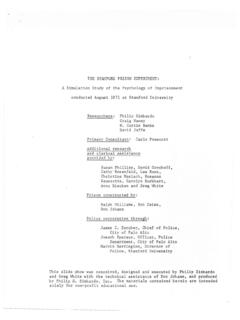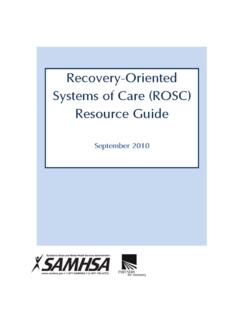Transcription of Social Media and Fake News in the 2016 Election
1 Journal of Economic Perspectives Volume 31, Number 2 Spring 2017 Pages 211 236 American democracy has been repeatedly buffeted by changes in Media tech-nology. In the 19th century, cheap newsprint and improved presses allowed partisan newspapers to expand their reach dramatically. Many have argued that the effectiveness of the press as a check on power was significantly compro-mised as a result (for example, Kaplan 2002). In the 20th century, as radio and then television became dominant, observers worried that these new platforms would reduce substantive policy debates to sound bites, privilege charismatic or telegenic candidates over those who might have more ability to lead but are less polished, and concentrate power in the hands of a few large corporations (Lang and Lang 2002; Bagdikian 1983).
2 In the early 2000s, the growth of online news prompted a new set of concerns, among them that excess diversity of viewpoints would make it easier for like-minded citizens to form echo chambers or filter bubbles where they would be insulated from contrary perspectives (Sunstein 2001a, b, 2007; Pariser 2011). Most recently, the focus of concern has shifted to Social Media . Social Media platforms such as Facebook have a dramatically different structure than previous Media technologies. Content can be relayed among users with no significant third party filtering, fact-checking, or editorial judgment. An individual user with no track record or reputation can in some cases reach as many readers as Fox news , CNN, or the New York Times.
3 Social Media and fake news in the 2016 Election Hunt Allcott is Associate Professor of Economics, New York University, New York City, New York. Matthew Gentzkow is Professor of Economics, Stanford University, Stanford, California. Both authors are Research Associates, National Bureau of Economic Research, Cambridge, Massachusetts. For supplementary materials such as appendices, datasets, and author disclosure statements, see the article page doi= Allcott and Matthew Gentzkow212 Journal of Economic PerspectivesFollowing the 2016 Election , a specific concern has been the effect of false stories fake news , as it has been dubbed circulated on Social Media .
4 Recent evidence shows that: 1) 62 percent of US adults get news on Social Media (Gottfried and Shearer 2016 ); 2) the most popular fake news stories were more widely shared on Facebook than the most popular mainstream news stories (Silverman 2016 ); 3) many people who see fake news stories report that they believe them (Silverman and Singer-Vine 2016 ); and 4) the most discussed fake news stories tended to favor Donald Trump over Hillary Clinton (Silverman 2016 ). Putting these facts together, a number of commentators have suggested that Donald Trump would not have been elected president were it not for the influence of fake news (for examples, see Parkinson 2016 ; Read 2016 ; Dewey 2016 ).
5 Our goal in this paper is to offer theoretical and empirical background to frame this debate. We begin by discussing the economics of fake news . We sketch a model of Media markets in which firms gather and sell signals of a true state of the world to consumers who benefit from inferring that state. We conceptualize fake news as distorted signals uncorrelated with the truth. fake news arises in equi-librium because it is cheaper to provide than precise signals, because consumers cannot costlessly infer accuracy, and because consumers may enjoy partisan news . fake news may generate utility for some consumers, but it also imposes private and Social costs by making it more difficult for consumers to infer the true state of the world for example, by making it more difficult for voters to infer which electoral candidate they prefer.
6 We then present new data on the consumption of fake news prior to the elec-tion. We draw on web browsing data, a new 1,200-person post- Election online survey, and a database of 156 Election -related news stories that were categorized as false by leading fact-checking websites in the three months before the Election . First, we discuss the importance of Social Media relative to sources of political news and information. Referrals from Social Media accounted for a small share of traffic on mainstream news sites, but a much larger share for fake news sites. Trust in information accessed through Social Media is lower than trust in traditional outlets. In our survey, only 14 percent of American adults viewed Social Media as their most important source of Election news .
7 Second, we confirm that fake news was both widely shared and heavily tilted in favor of Donald Trump. Our database contains 115 pro-Trump fake stories that were shared on Facebook a total of 30 million times, and 41 pro-Clinton fake stories shared a total of million times. Third, we provide several benchmarks of the rate at which voters were exposed to fake news . The upper end of previously reported statistics for the ratio of page visits to shares of stories on Social Media would suggest that the 38 million shares of fake news in our database translates into 760 million instances of a user clicking through and reading a fake news story, or about three stories read per American adult.
8 A list of fake news websites, on which just over half of articles appear to be false, received 159 million visits during the month of the Election , or per US adult. In our post- Election survey, about 15 percent of respondents recalled seeing each of 14 Hunt Allcott and Matthew Gentzkow 213major pre- Election fake news headlines, but about 14 percent also recalled seeing a set of placebo fake news headlines untrue headlines that we invented and that never actually circulated. Using the difference between fake news headlines and placebo headlines as a measure of true recall and projecting this to the universe of fake news articles in our database, we estimate that the average adult saw and remembered fake stories.
9 Taken together, these estimates suggest that the average US adult might have seen perhaps one or several news stories in the months before the , we study inference about true versus false news headlines in our survey data. Education, age, and total Media consumption are strongly associated with more accurate beliefs about whether headlines are true or false. Democrats and Republicans are both about 15 percent more likely to believe ideologically aligned headlines, and this ideologically aligned inference is substantially stronger for people with ideologically segregated Social Media networks. We conclude by discussing the possible impacts of fake news on voting patterns in the 2016 Election and potential steps that could be taken to reduce any negative impacts of fake news .
10 Although the term fake news has been popularized only recently, this and other related topics have been extensively covered by academic literatures in economics, psychology, political science, and computer science. See Flynn, Nyhan, and Reifler (2017) for a recent overview of political misperceptions. In addition to the articles we cite below, there are large literatures on how new infor-mation affects political beliefs (for example, Berinsky 2017; DiFonzo and Bordia 2007; Taber and Lodge 2006; Nyhan, Reifler, and Ubel 2013; Nyhan, Reifler, Richey, and Freed 2014), how rumors propagate (for example, Friggeri, Adamic, Eckles, and Cheng 2014), effects of Media exposure (for example, Bartels 1993, DellaVigna and Kaplan 2007, Enikolopov, Petrova, and Zhuravskaya 2011, Gerber and Green 2000, Gerber, Gimpel, Green, and Shaw 2011, Huber and Arceneaux 2007, Martin and Yurukoglu 2014, and Spenkuch and Toniatti 2016 .)












